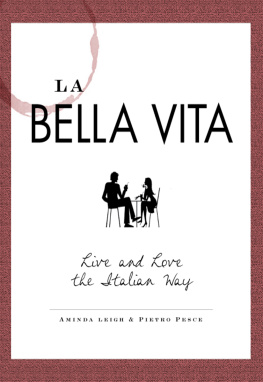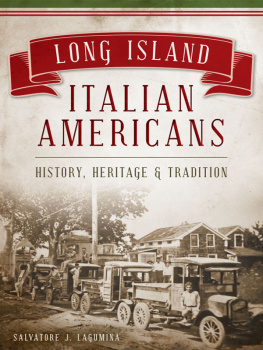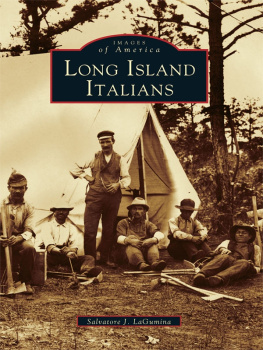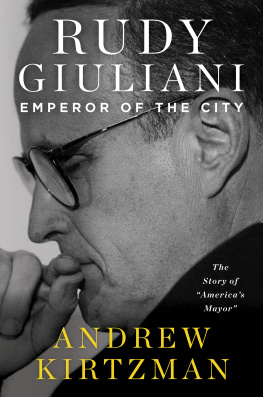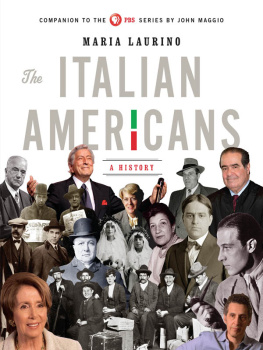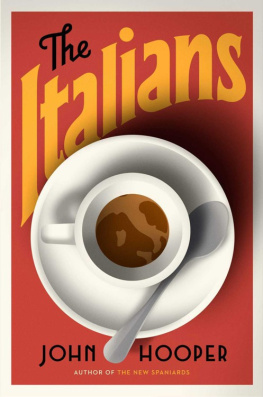English edition, 2012 New Academia Publishing
Translated from Gli Italiani di New York , 2011, Gius. Laterza & Figli
Translator, Louise Hipwell
All rights reserved. No part of this book may be reproduced or transmitted in any form or by any means, electronic or mechanical, including photocopying, recording, or by any information storage and retrieval system.
Library of Congress Control Number: 2012944759
ISBN 978-0-9855698-0-8 paperback (alk. paper)
 | An imprint of New Academia Publishing |
 | New Academia Publishing, LLC P.O. Box 27420, Washington, DC 20038-7420 www.newacademia.com - info@newacademia.com |
All photos by the author if not otherwise indicated.
To Eli, Chana, Dan, Naomi and their grandparents
Introduction
If you want to learn something about Italian creativity, come to New York. Here youll find Italian pride at the Fifth Avenue Columbus Day Parade, the American patriotism of those who lost their lives at Ground Zero, the courage of firefighters and marines on the frontlines of the war against terrorism, a babel of dialects at the Arthur Avenue market, portrayals of social change in the writings of Gay Talese, stories of successful business ventures on the TV shows of Maria Bartiromo and Charles Gasparino, political passion in the battles of Mario Cuomo and Rudy Giuliani, creative imagination in the works of Gaetano Pesce, Renzo Piano and Matteo Pericoli, and provocation in the attire of Lady Gaga. Youll find the enthusiasm of the younger generations on the stages of Broadway, on the trading floors of Wall Street, in the classrooms of the Columbia University Business School, and also among the illegal immigrants who live precariously, surviving with the help of charitable priests and missionaries who run frontier churches, in those places where the mafia has not yet been defeated.
New York melds and amasses Italian identities from both the past and the present; not all of the more than 3.3 million Italians who live in New York share the same background and cultural perspectives. The top managers of the Midtown banks who arrived in the last twenty years are oriented towards XXI century life whilst, on Fresh Pond Road in Ridgewood, Sicilian style panelle are made following recipes that have been passed down for generations. In Larry Gagosians gallery, a temple of contemporary art on the very exclusive Madison Avenue, a forty year old Turinese woman works tirelessly to reinvent Pablo Picasso. In the laboratories of New York University, it is a female Italian doctor who is at the fore in the fight against cancer. In the classrooms of Rutgers University, twenty year old grandchildren and great grandchildren of immigrants who came through Ellis Island dedicate themselves to their textbooks to learn the language of Dante that wasnt taught to them at home.
What sets the Italians of New York apart is the energy with which they debate their Italian identity. An eighty year old reporter for America Oggi talks about the Italian Americans who meet up at countless religious holiday celebrations, clubs and associations. Each one of them defines him/herself in reference to a specific geographical place of origin, not a region but a city, town, village or even small suburban area. Researchers at the Calandra Institute prefer the term American-Italians because the characteristics they have acquired in their new homeland prevail over the heritage of the Old Country. On Mulberry Street, the last street of Little Italy on the Lower East Side, the use of the term Italians has declined and has been replaced with terms such as Calabrian, Sicilian, Neapolitan, and Apulian. US Navy Admiral Edmund Giambastiani considers himself an American of Italian descent as do police officers, firefighters and soldiers who safeguard national security. Top pharmaceutical manager Lamberto Andreotti and UN veteran Giandomenico Picco speak of having a global identity with an Italian component. An ex-paparazzo who moved to Harlem from Rome points to the photographs on the wall of his restaurant, the sculptor Arturo Di Modica cites the freedom to create what comes naturally to me without having to submit to the diktat of the galleries, for Lady Gaga it suffices to recall her grandfather.
It all culminates in a universe of voices and values where contradictions abound. In some families, parents forbid their children to see The Godfather because they consider it an expression of a very dangerous anti-Italian prejudice. This sentiment is in tune with the complaints expressed by the resolute activists of the NIAF (National Italian American Foundation) and the Italian Citizens Foundation against the TV series The Sopranos and the reality TV show Jersey Shore which are accused of presenting an image of mobsters and tacky youths. For Anthony J. Tamburri, the director of the Calandra Institute, Jersey Shore , instead, helps to better understand what is occurring within the American working class and the Americanist Franco Zerlenga goes even further, explaining that one of the distinguishing characteristics of the Italians of New York is that they dont lament their lot like others do. In the Bronx there are vendors who sell car tags displaying the words Cosa Nostra. In the classrooms at Rutgers University there are people who willing to fight anyone who flings the insult Mafioso at a third generation Italian, with their bare hands. As for politics, the elections for governor in New York put the spotlight on the duel between the Democrat Andrew Cuomo and the Republican Carl Paladino. As a result of their very different experiences of integration, Cuomo emphasized his complete integration into the American way and Paladino, instead, exalted his ethnic background. Beyond this, in some churches in Brooklyn mass is said in Italian for the older generations and in English for the younger church-goers. But it could be said perhaps that food is the common ground that best summarizes the Italian cultural mosaic. Thousands of restaurants, supermarkets, delis, butchers, bakeries, pizzerias, bars, coffeehouses and stands offer dishes and foods that describe the parabola of flavors that echo those of the immigrants themselves. It all began with the flavors of the original Italian dishes which were then modified by the impact of the ingredients that were actually accessible. Little by little restaurants went back to serving authentic Italian cuisine, or as in the case of Del Posto, the only Italian restaurant that can boast four stars from the New York Times, they moved a step further to include the best of American products and flavors.
From the church-goers on Saint Padre Pio Way in Williamsburg, to the customers at the Festa di San Gennaro in Little Italy, to the patrons of the rooftop bars of Manhattan, there is always an element that distinguishes the Italians of the Big Apple: the belief that if you give it your all, anything is possible. These days, the twenty year olds coming to study at the best universities or choosing to face the risks of life as illegal immigrants share an expression with the immigrants of the past: we are hardworking people.


